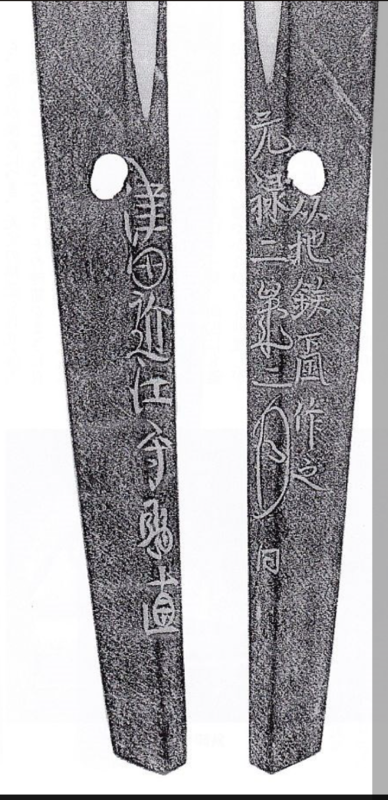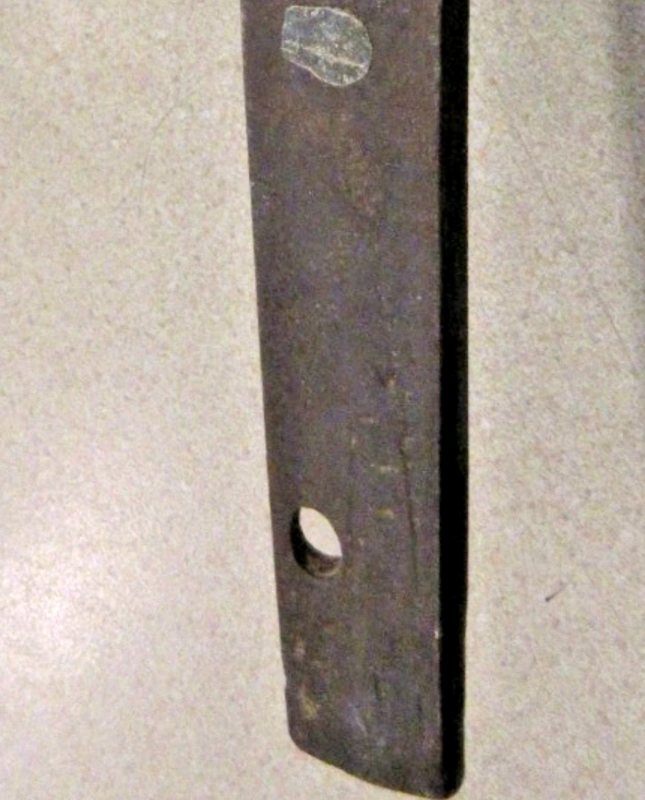-
Posts
5,198 -
Joined
-
Last visited
-
Days Won
140
Content Type
Profiles
Forums
Events
Store
Downloads
Gallery
Everything posted by Ray Singer
-
You can review a really extensive discussion on Shintogo at the link below with many reference examples to compare with. o
-

Help Requested with Date on Kai-Gunto Blade
Ray Singer replied to tbonesullivan's topic in Translation Assistance
The date is : Eiroku hachi nen ju gatsu kichi jitsu A lucky day the 10th month of 1567 The mei is correctly translated as Mihara Masamori saku. I think it is a safe guess that this is an authentic, late Muromachi Kai Mihara blade and not gimei. -
I have two websites.
-
Sky, all of the swords on my website are (or were) for sale including the tokuju Masamune. In the case of the Rai Kunimitsu, it is no longer available and I have removed the link, however I have worked with the Bensons in the past (to explain the replicated content). If there is a specific question on the swords I have posted on my website, please let me know. Best regards, Ray
-
That is at least who it's purporting to be.
-
-
https://www.google.com/search?q="備州長船長義"&client=ms-android-google&sca_esv=99ba87713a6b4ed1&sxsrf=AE3TifOTHx5mm-VkiUVxN7FX3BgZ3mBPhg%3A1764288735386&ei=3-goafKoF9O3wt0P2pi4WQ&oq="備州長船長義"&gs_lp=EhNtb2JpbGUtZ3dzLXdpei1zZXJwIhQi5YKZ5bee6ZW36Ii56ZW3576pIjIFEAAY7wUyBRAAGO8FMgUQABjvBTIFEAAY7wUyBRAAGO8FSPZ5UP0tWPJ5cAB4AJABAZgBqwGgAaAFqgEDMS40uAEDyAEA-AEBmAIEoAKaBMICCBAAGLADGO8FwgIEECMYJ5gDAIgGAZAGBZIHAzEuM6AHkRGyBwMxLjO4B5oEwgcFMi0yLjLIByM&sclient=mobile-gws-wiz-serp#ip=1
-
No, I believe it is 應安 (Ōan). Unfortunately, this is very likely to be gimei.
-
Signed: Bizen no kuni Osafune ju Chogi (Nagayoshi) Dated: Oan roku nen hachi gatsu hi
-
This type of mei only refers to the swordsmith and where he worked (not a documentation of the provenance and indicate past ownership). Unless you have a surrender tag attached, it is unlikely that you would be able to trace back.
-
The inscription is Hizen (no) kuni Tadayoshi. You can research at the website below. Hizento.com Irrespective of the inscription, it is an authentic antique Japanese sword
-

Requesting help with signature
Ray Singer replied to Flyingtigerfan's topic in Military Swords of Japan
Noshu Seki ju niju sandai Kanefusa saku kore This was the 23rd generation of Mino Kanefusa. You'll find other examples of his work by searching the discussion board here. -
As mentioned in your other post, the sword appears to be late Muromachi period
-
Please see below for Ogawa Kanekuni. https://www.google.com/search?q="ogawa+kanekuni"+site%3Amilitaria.co.za&sca_esv=18637f1ce6371d1f&rlz=1C1YTUH_enUS1164US1164&sxsrf=AE3TifOV34tbjjQ9yRuvGop5ne4Ec7zGcg%3A1763671772968&ei=3H4faergOsybwbkPwdKH2A4&ved=0ahUKEwjqvpyszYGRAxXMTTABHUHpAesQ4dUDCBE&uact=5&oq="ogawa+kanekuni"+site%3Amilitaria.co.za&gs_lp=Egxnd3Mtd2l6LXNlcnAiJSJvZ2F3YSBrYW5la3VuaSIgc2l0ZTptaWxpdGFyaWEuY28uemFI1BFQ1QFYkA9wAXgAkAEAmAGMAaABuQWqAQMzLjS4AQPIAQD4AQH4AQKYAgegApYFwgIHEAAYsAMYHsICCxAAGIAEGLADGKIEwgIIEAAYsAMY7wXCAgYQABgWGB7CAggQABiABBiiBMICBRAAGO8FwgIFECEYoAHCAgUQIRirApgDAIgGAZAGBZIHAzIuNaAH2A6yBwMxLjW4B5EFwgcFMy4yLjLIBw8&sclient=gws-wiz-serp
-
Noshu Seki ju Kanekami saku. I would look into the late Muromachi Sue-Seki group. Best regards, Ray
-
I believe it is Yasushige, a lucky day in July 1940. https://www.google.com/search?q=Yasushige+site%3Awww.militaria.co.za&oq=Yasushige+site%3Awww.militaria.co.za+&gs_lcrp=EgZjaHJvbWUyBggAEEUYOTIHCAEQIRiPAjIHCAIQIRiPAjIHCAMQIRiPAtIBCDY1NjRqMGo0qAIOsAIB8QW-XY9Q0JG6bQ&client=ms-android-google&sourceid=chrome-mobile&ie=UTF-8
-

NBTHK document genuine or forged?
Ray Singer replied to noel_azzopardi's topic in General Nihonto Related Discussion
Generally, yes. 1864-1865 is a representative time period and does not reflect the smith's entire career (he worked more than two years). -

NBTHK document genuine or forged?
Ray Singer replied to noel_azzopardi's topic in General Nihonto Related Discussion
I don't see a reason for concern. Sa Yasuchika (Chikuzen - Shinshinto) Credit Markus Sesko for the bio below. YASUCHIKA (安近), Genji (元治, 1864-1865), Chikuzen – “Sa Yasuchika” (左安近), “Chikuzen no Kuni-jū Sa Yasuchika saku” (筑前国住左安近作), “Chikushū-jū Sa Yasuchika saku” (筑州住左安近作) -
A Kicho ninteisho. Every sword should be evaluated individually against its certification, however in my personal experience it is the Tokubetsu Kicho ninteisho that are more problematic.
-
Mei Kunikane (kodai). This means later generation. If it was felt to be gimei, the ninteisho would not have been issued. Best regards, Ray
-
I received several dozen books today and this includes another Fujishiro with Afu translations. Please message me to discuss further. Best regards, Ray
-

WW2 Japanese Naval Sword
Ray Singer replied to Swords's topic in Auctions and Online Sales or Sellers
-
Hi, only these seven books remain available. 1. Kanto Zuiroku - $195.00 + shipping 2. Shinshinto Taikan - $375.00 + shipping 3. Gendaito Meisaku Zuikan - $295 + shipping 4. Samurai Revolution - $75.00 + shipping 5: Katana: The Samurai Sword - $15.00 + shipping 6. Japanese sword guards from the Peabody Museum - $40 + shipping 7. Japanese Art Signatures: - $95 + shipping
-
https://www.google.com/search?q=takehisa+site%3Amilitaria.co.za&sca_esv=ed6f5ed44ddb5799&rlz=1C1YTUH_enUS1164US1164&sxsrf=AE3TifP5Pi-5FtCBUVzJJdiM-yVq53n6cQ%3A1762781650289&ei=0ukRaduxEaaEwbkP4PysgQs&ved=0ahUKEwjb4tOw2eeQAxUmQjABHWA-K7AQ4dUDCBE&uact=5&oq=takehisa+site%3Amilitaria.co.za&gs_lp=Egxnd3Mtd2l6LXNlcnAiHXRha2VoaXNhIHNpdGU6bWlsaXRhcmlhLmNvLnphSLkQUJcCWJcCcAF4AJABAJgBc6ABsAGqAQMxLjG4AQPIAQD4AQL4AQGYAgCgAgCYAwCIBgGSBwCgB1qyBwC4BwDCBwDIBwA&sclient=gws-wiz-serp
-
I just received two kaigunto. One with a koto blade (which just sold) and the second with an Ishido Teruhide. I will email you details. Best regards, Ray





